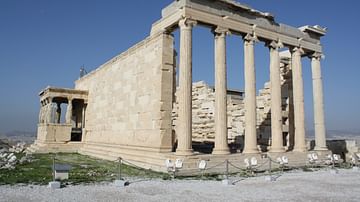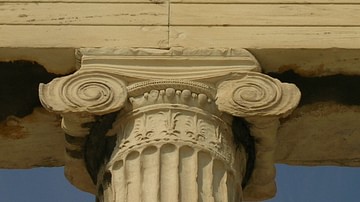
The column was an architectural invention that allowed for the support of ceilings without the use of solid walls. Columns increase the space which can be spanned by a ceiling, allowing the entrance of more light. Columns also offer an alternative aesthetic to building exteriors.
In the ancient world, columns were used particularly in the peristyles of temples and in colonnades along stoas. Columns could also be incorporated (engaged) within walls or be free-standing and so carry sculptures to commemorate particular events or people.
Early Architectural Columns
The first use of columns was as a single central support for the roof of relatively small buildings but from the Bronze Age (3000-1000 BCE) more sophisticated columns with other functions beyond direct structural support appeared in the Egyptian, Assyrian and Minoan civilizations. Whilst the former civilizations employed stone for their columns, the Minoans used whole tree-trunks, usually turned upside down in order to prevent re-growth, stood on a base set in the stylobate (floor base) and topped by a simple round capital. These were then painted as in the most famous Minoan palace of Knossos. The Minoans employed columns to create large open-plan spaces, light-wells and as a focal point for religious rituals. These traditions were continued by the later Mycenaean civilization, particularly in the megaron or hall at the heart of their palaces. The importance of columns and their reference to palaces and therefore authority is evidenced in their use in heraldic motifs such as the famous lion-gate of Mycenae where two lions stand each side of a column. Being made of wood these early columns have not survived, but their stone bases have and through these we may see their use and arrangement in these palace buildings.
The First Stone Columns
In Archaic Greece stone began to replace wood as the primary building material for large buildings. However, the transition was by no means clear-cut. Temples from the 8th to mid-7th centuries BCE at Isthmia, Ephesus and Corinth are believed to have employed wooden columns with stone bases alongside other structural elements in stone. Gradually though, and with the exception of roof beams, stone, with its superior strength and durability became the favoured material used in construction.
Whilst some stone columns were carved in one piece, as buildings became bigger, columns began to be constructed from separate drums. These were individually carved and fitted together using a wooden dowel or metal peg in the centre of the drum. Columns made from individual drums are remarkably resistant to seismic activity. The elasticity provided by the possibility of fractional movements between drums means that the collapse of such columns is almost always due to other destructive forces such as high winds or weakening of the building through the removal of stone elements for re-use elsewhere, rather than earthquakes. Despite this advantage though, the Romans preferred single monolithic shafts for their columns. The Romans also standardised column production from the 1st century BCE, preferring the ratio of 6:5. That is the height of the column shaft was five-sixths of the total height of the column with its base and capital. Celebrated examples of this type of column may be seen in the Pantheon of Rome.
Columns & the Architectural Orders
The evolution of columns in the ancient world has been classified within architectural orders. The three principal orders are Doric, Ionic, and Corinthian. First though, we may place Egyptian columns which stood on a base and carried sculpted decoration of leaves on the column shaft and Persian columns which often had animal figures such as bulls as their capitals. In the Greek world the first order was Doric whose columns were wider at the bottom and had a simple capital but no base. Ionic columns stand on a base and have a capital in the form of a double scroll (volute). Corinthian columns are usually slimmer and taller, stand on a base and have a richly decorated capital, usually with sculpted flower and leaf decoration. These three all have vertical fluted carving. The Romans introduced the Tuscan column which had no flutes and a simple base and capital. Roman Doric columns were similar but with flutes. Composite columns appeared which mixed elements of the previous styles and finally, there were Solomonic columns with a twisted shaft.
Columns also incorporated geometric refinements in order to overcome some of the problems of optical illusion in large buildings. This is that actually straight lines seem to be curved when viewed from a distance. Therefore, columns often inclined slightly inwards as they rose, corner columns were slightly fatter and each column bulged slightly in the middle (entasis) all in order for the building to appear perfectly straight. The most famous example of these techniques is undoubtedly the Parthenon on the Athenian acropolis.
Free-Standing Columns
Columns became so much a part of the aesthetic look of a building that the columns themselves began to become independent artistic elements. The bull-man columns of Persepolis and the Caryatids of the Erechtheion in Athens in the 5th century BCE are celebrated as works of art in their own right, independent of the structures they were originally designed to support.
Perhaps the most famous free-standing columns are the Ionic Naxian Sphinx column at Delphi (560 BCE) which was 10m high and Trajan's Column in Rome (113 CE) which stood over 30 metres high. Nearly 200 m of continuous frieze spiral around the column depicting over 2,500 figures illustrating the emperor's campaign victories in Dacia. The column was also originally topped by a statue of the emperor himself.







